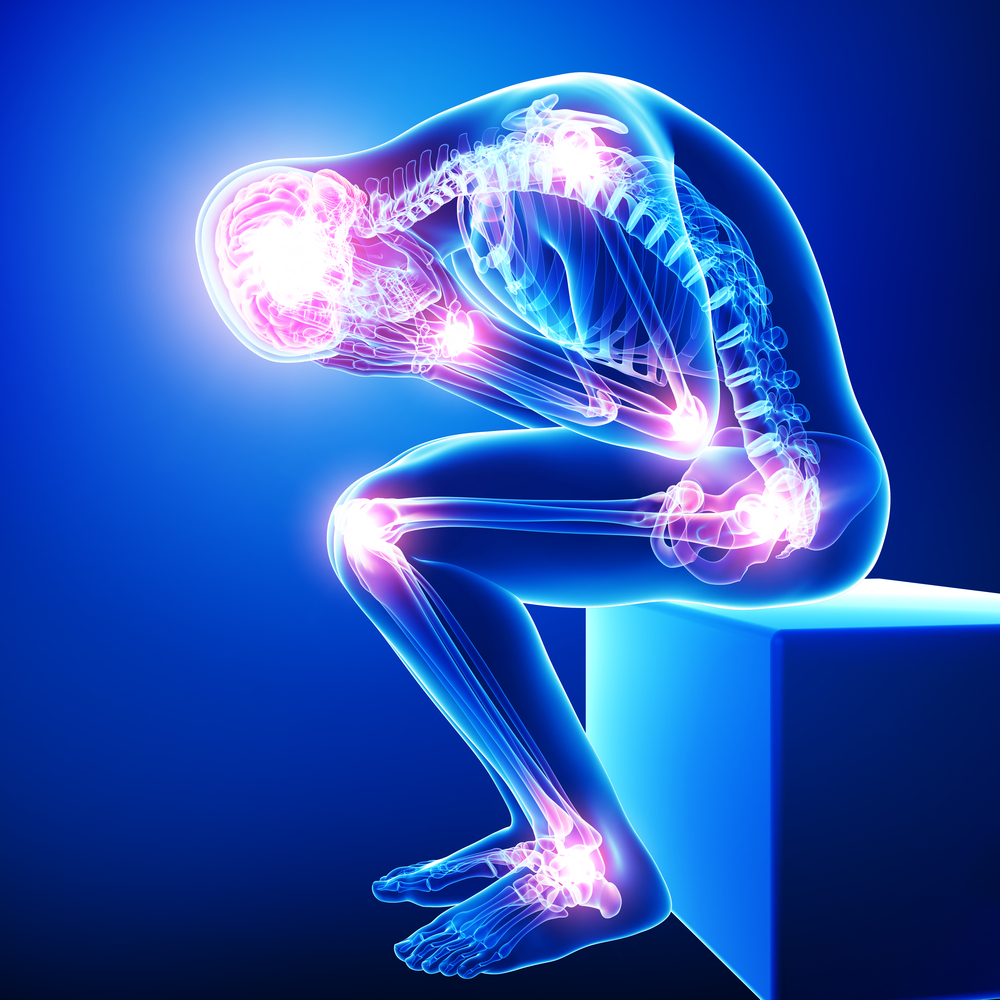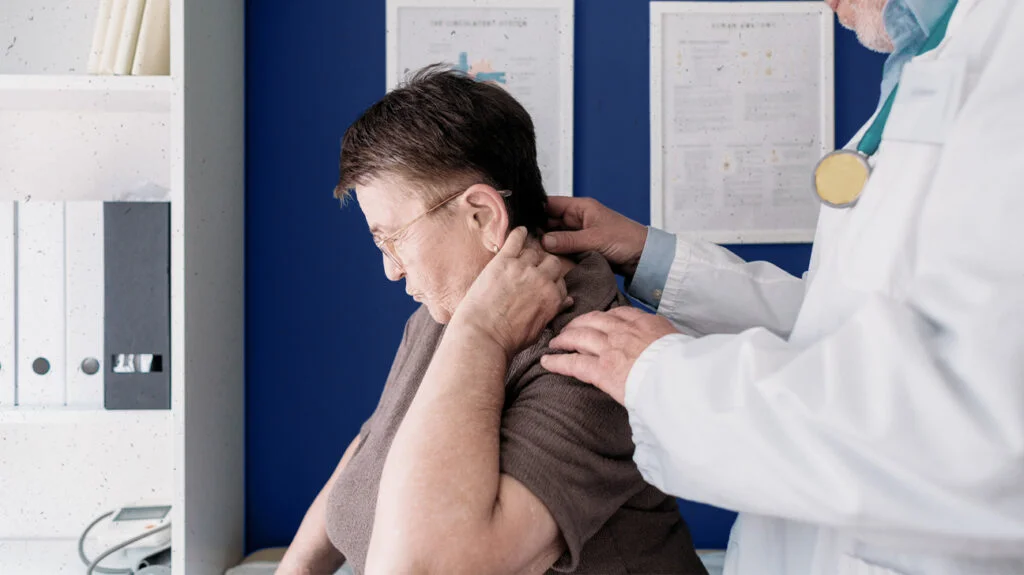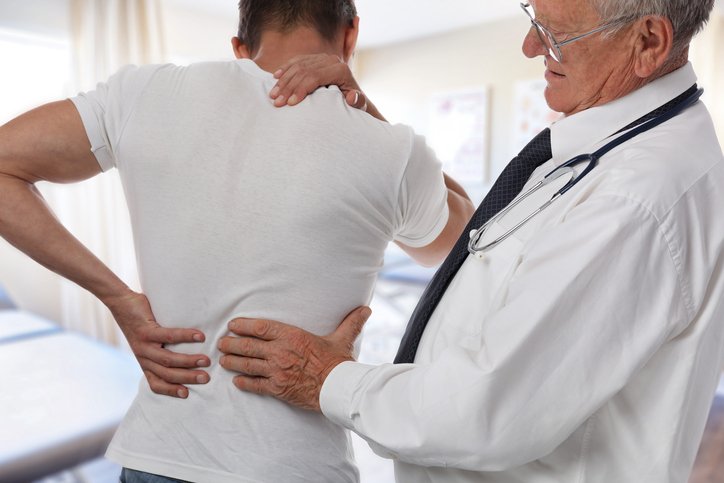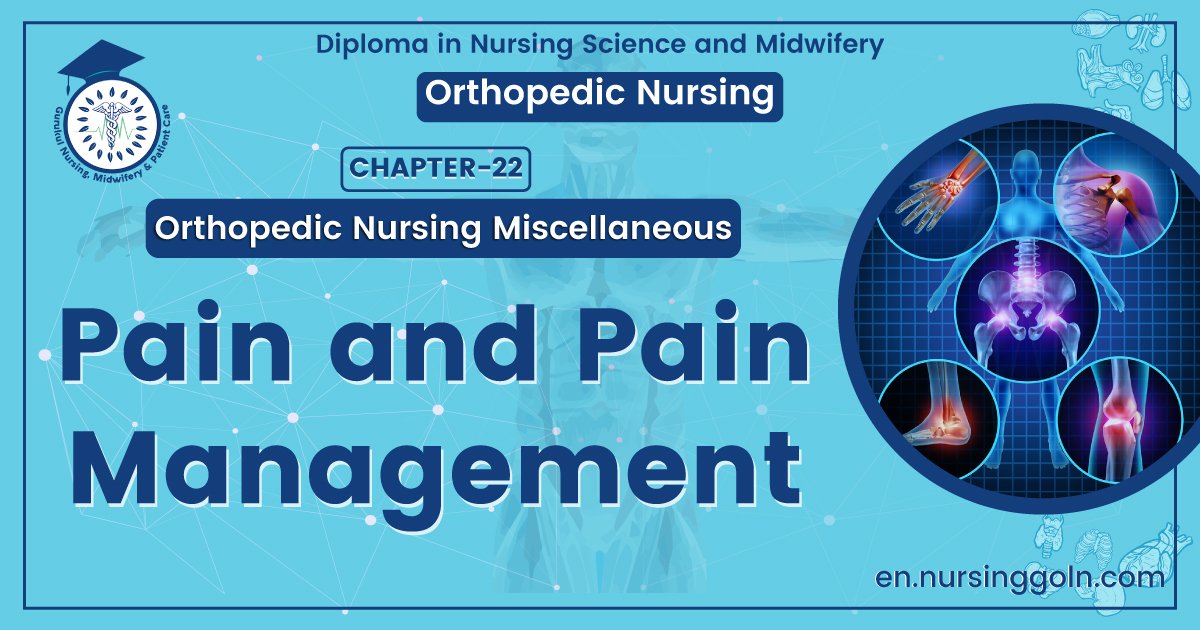Concept About Pain & Pain Management – An orthopedic nurse is a nurse who specializes in treating patients with bone, limb, or musculoskeletal disorders. Nonetheless, because orthopedics and trauma typically follow one another, head injuries and infected wounds are frequently treated by orthopedic nurses.
Ensuring that patients receive the proper pre-and post-operative care following surgery is the responsibility of an orthopedic nurse. They play a critical role in the effort to return patients to baseline before admission. Early detection of complications following surgery, including sepsis, compartment syndrome, and site infections, falls under the purview of orthopedic nurses.
Concept About Pain & Pain Management
Definition of pain:
Pain is derived from the Latin word ‘poinea’ which means penalty/punishment. Pain is an unpleasant sensory and emotional experience associated with acute or chronic potential tissue damage (International Association of the Study of pain: IASP) “Whatever the experiencing person says it is, and existing whenever the experiencing person says it does”
Types of pain:
A. According to the pathophysiology:
1. Nociceptive pain: Pain resulting from activation of primary afferent nociceptors by mechanical, thermal or chemical stimuli. E.g: pain related to the wound, fracture, burn or angina.
2. Neuropathic pain: Pain resulting from damage to peripheral nervous or central nervous system tissue or from altered processin g of pain in the CNS. E.g: pain in amputed limb, continuous pain.

B. According to the time:
1. Acute pain: Occurs abruptly after an injury or disease persists until healing occurs and often is intensified by anxiety or fear. E.g; Bone fracture, burn, surgery, sickle cell crisis, tension etc.
2. Chronic pain: Pain lasts from a prolong period of time. Can not amenable to specific therapy or treatment. E.g: Prolong tissue pathology, Stable angina, Gout, Gastitis Low back pain etc.
C. According to the origin:
1. Superficial pain: Originate in the skin and subcutaneous tissue.
2. Deep somatic pain: Pain arises from ligament, tendon, blood vessels etc.
3. Visceral pain: Stimulation of pain receptor in the abdominal cavity, cranium and thrax.
D. According to where it is experienced in the body:
1. Radiating pain.
2. Referred pain.
3. Phanthom pain.
4. Shifting pain.

Assess severity of pain of a orthopatient:
Pain assessment is the first step of pain management. Assessment should be done on admission and on a regular basis. The steps are usually used in pain assessment those are listed below:
1. Accept the patient report– 1 step in the pain assessment is to established rapport with the patient and accept what says about the pain. Listen silently, maintaining eye contact, touch the patient and clarify information in an unharried manner. You must be follow:
a) Behavioral response:
- Body position (chest pain; propped up)
- Moaning
- Grimacing
- Crying
- Restlessness
- Immobility
- Muscle twisting.
b) Facial expression changes:
i. Wrinkled forehead
ii. Anxiety
iii. Depression
iv. Toxic
v. Head lower down
vi. Irritability
vii. Fro cone eyebrow
2. Determine the patient status of pain: To determine the patient status of pain, a patient is asked to severity of pain.
a) Asking:
- Had the pain was before?
- How long stayed?
- As it new occurance of diseases?
- On the basis of patients response and history taking decide whether pain is chronic or acute and whether needs immediate treatment
b) Verbalize word: like ouch, boo, hurt, loud crying etc.
c) Physical examination: Observe some pain modalities like HR.↑, BP.1, PR.↑, Pallor, dilatedpupils, diaporosis
3. Describe the pain in the terms of OLDCARTS:
- 0= Onset of pain.
- L=location of pain.
- D=Duration of pain.
- C=Characteristics of pain.
- A=Aggravating factors (e.g: exertion, cold)
- R= releaving factors. (rest releaving factors; angina)
- T=Treatment
- S=Severity of pain.
4. Examine the site of pain: Asking the pts where is pin to determine the site and assess the site for-
- Heat Cold
- Redness
- Swelling
- Tenderness
- Abnormal position
5. Identify coping methods: Confirm how the pts copes with pain. Any knowledge about coping pain, Asking the pts what he/she do to reduce pain.
- Any medication.
- Breathing
- Changing position.
- Distraction( such as music, song, video games),
- Guided imagery.
- Sedation.
6. Document: Assessment, findings and evaluate interventions: Write down the information of pts chart against pain. Identify the location, sorting data, reject unnecessary data, summarize site, cause, what should taken to prevent recurrence.

Or
Know the key steps in pain assessment:
A. “ABCDE” Clinical Approach.
B. The Use of Pain Scales.
C. Pain History.
D. Total Pain.
V. Other Important Points about Pain Assessment.
Unfortunately, poorly controlled pain is common in patients with advanced illness. While physicians are by no means the only contributors to the problem of inadequate pain relief, we do contribute substantially. Our most common deficits, all seemingly simple to remedy, are failures to:
- Recognize that the patient is in pain
- Prescribe adequate dosing of opioids,
- Treat side effects of opioids effectively Reassess pain after initial treatment.
Patient characteristics may increase the risk of being inadequately treated pain. These characteristics include:
- Age (elders and children both).
- Race/ethnicity (minority groups).
- Gender (female at higher risk).
- Impaired cognitive status
Studies show that the effect of pain on a patient’s quality of life and functional status is determined more by the severity of the worst pain they experience over a 24 hour period than the average pain they experience.
A. “ABCDE” Clinical Approach:
A clinical approach to pain assessment and management is summarized by the mnemomis “ABCDE” (Weissman and Dahl, 1995):
- Ask about pain regularly and Assess pain systematically, see example questions C. below
- Believe the patient and family in their reports of pain (along with their reports of what works and what doesn’t).
- Choose pain control options appropriate for the patient, family, and setting
- Deliver interventions in a timely and coordinated fashion.
- Empower patients and their families and Enable them to control their treatment to the greatest extent possible.
B. The Use of Pain Scales:
Use of rating scales can be very helpful. However, it must be clear that the purpose of the scales is not to give an arbitrary evaluation of pain or to calculate the correct dose of an opioid; rather it is to assist in understanding the patient’s experience of the pain. Most importantly, using the same rating system over time helps us to assess how effective our treatment is at relieving the patient’s pain and to make adjustments for maximum benefit. It is key to have a communication tool to help us understand how effective our treatment is and what changes are needed. Patients can use a 0 to 10 numeric scale or a scale that depicts facial expressions (happy grimacing).
Facial expression scales:

Some people find it easiest to use a simple range of words to describe their pain:
–no pain, a little pain, lots of pain, too much pain OR
–mild, medium and severe
Pain scales are now a standard tool in most hospitals and other clinical settings, typically the 0-10 numerical scale.
C. Pain History
A careful pain history is central to good pain assessment. The key components (PPQRST) are:
- Palliating factors: What makes the pain better? What do you do to get relief? What helps you?
- Provocative factors: What makes the pain worse? What brings it on? What aggravates it?
- Quality of pain: What does the pain feel like? What words would you use to describe it?Examples: aching, throbbing, sharp, squeezing, shooting, burning, dull, stabbing, deep, cramping.
- Radiation: Where is the pain? Does the pain spread or travel anywhere else?
- Severity: How bad is the pain? At its worst? At its best?
- Temporal course: When did the pain start? How often does it hurt? Has it gotten better? Worse? Is it worse at certain times of the day?
- Treatment: What have you tried to relieve the pain? How effective was it? Why did you stop it?

D. Total Pain
“Total pain” is comprised of many factors:
- Environmental (crowding, noise, temperature control)
- Physical (nociceptive, neuropathic)
- Psychological (depression, anxiety)
- Social (family conflicts, job worries)
- Spiritual (why me? abandoned by God? meaning of life and illness?)
- Financial/legal (job loss, family security, estate planning)
Good pain management addresses all the components of a patient’s pain, often with the help of an interdisciplinary team. Although all these components play a role in the experience of pain, we should be wary about attributing pain entirely to any one component (e.g. “his pain is all psychological). This is virtually never an accurate judgment in the clinical setting. Furthermore, pain hurts and needs relief, no matter what its components are. Recognizing the pain of the “whole person” should lead us to a multiple-dimensional treatment plan, not to rejection or abandonment of the patient. Often experts use the term “suffering” for this set of complex sources of distress.
E. Other Important Points about Pain Assessment:
- It is VERY important to treat the pain during the assessment process you do not need to wait until your “thorough assessment” is complete before you begin to provide pain relief for most patients.
- As part of the assessment, take a careful history of analgesic use, including prior and present medications, analgesic response (time to onset of peak effect, duration of action, level of pain relief (0 to 10 scale]), and side effects.
- A focused physical exam is an important part of the assessment process
- When possible, determine the cause of the pain (bowel obstruction, epidural metastases, brachial plexopathy, etc.) and institute appropriate, diagnosis-specific therapy for the pain.
Reevaluate the pain and the efficacy of treatment frequently, and adjust treatment accordingly. - An appreciation of the patient’s social support system is critical to managing pain in advanced illness. Who does she live with? Does he belong to a religious or faith-based community? Does she have family nearby? What additional resources does he have for support?
A trial of placebos to make sure pain is “real” is NEVER appropriate. The rate of placebo response to all types of pain is relatively high; therefore this provides no insight into the nature of the pain. Furthermore, a placebo trial without patient consent can be very destructive to the doctor-patient relationship (and it is considered unethical by most authorities). Finally, all pain is REAL to the person experiencing it.
Types of pain scale:
1. Unidimensional pain intensity scales. Unidimensional scales are quick and easy to use, provide rapid feedback about the effectiveness of interventions, and are valid and reliable measures of pain intensity. Because the unidimensional scales measure only intensity, they cannot substitute for a comprehensive pain assessment. The unidimensional pain intensity scales used most often in the clinical setting are:
- Numeric Rating Scale (NRS), also known as the Numerical Pain Intensity Scale (NPI);
- Visual Analog Scale (VAS), and
- Verbal Descriptor Scale (VDS).
2. Numeric Rating Scale. The NRS can be used graphically (visually) or verbally. When used graphically, the NRS consists of a vertical or horizontal line that is anchored by the number 0 on the bottom or the left side and the number 10 on the top or the right side. Patients are instructed to rate the intensity of their pain on this scale, with “0” indicating no pain, and “10” indicating the worst pain imaginable.
3. Visual Analog Scale. The VAS is a 10-cm (100-mm) line on which the patient is asked to place a mark that corresponds with his or her current pain intensity. The line is then measured from the beginning to the patient’s mark, and this distance is translated into a pain intensity score ranging from 0 to 10. The format of scale, coupled with the need for a marking implement and for the patient to be able to clearly visualize and mark the line, make the VAS impractical to use in the clinical setting.
4. Verbal Descriptor Scale. The VDS uses the verbal descriptors “no pain,” “mild pain,” “moderate pain,” “severe pain,” “very severe pain,” and “worst pain possible.” This scale can be administered verbally or visually, and the patient is instructed to pick the words that best describe his or her current pain intensity.
Behavioral indicators of pain:
The third step in the hierarchy requires the nurse to observe the patient for possible indicators of pain, such as grimacing or other indicative facial expressions, bracing, rocking, or changes in activity. Recognizing that certain behaviors may indicate pain, researchers have developed behavioral pain assessment tools for use in patients who cannot self-report. Many of these tools yield a behavioral score that can help determine the presence of pain, and when changes are noted, can be used to evaluate the effectiveness of interventions; however, a behavioral score is not a pain intensity score. If the patient cannot report the intensity of his or her pain, then the intensity is unknown.
Goal of Pain Assessment:
a) To capture the individual’s pain experience in a standardized way.
b) To help determine type of pain and possible etiology.
c) To determine the effect and impact the pain experience has on the.
d) Individual and their ability to function.
e) Basis on which to develop treatment plan to manage pain. f) To aid communication between interdisciplinary team members.
Therapies normally used with medicine to help control pain are:
- Heat: Heat helps decrease pain and muscle spasms. Apply heat to the area for 20 to 30 minutes every 2 hours for as many days as directed.
- Ice: Ice helps decrease swelling and pain. Ice may also help prevent tissue damage. Use an ice pack or put crushed ice in a plastic bag. Cover it with a towel and place it on the area for 15 to 20 minutes every hour as directed.
- Massage therapy: This may help relax tight muscles and decrease pain.
- Physical therapy: This teaches you exercises to help improve movement and strength, and to decrease pain.
- Transcutaneous electrical nerve stimulation (TENS): This is a portable, pocket-sized, battery-powered device that attaches to your skin. It is usually placed over the area of pain. It uses mild, safe electrical signals to help control pain.
- Spinal cord stimulation (SCS): An electrode is implanted near your spinal cord during a simple procedure. The electrode uses mild, safe electrical signals to relax the nerves that cause your pain.
Other things may help control or reduce pain:
- Aromatherapy: This is a way of using scents to relax, relieve stress, and decrease pain. Aromatherapy uses oils, extracts, or fragrances from flowers, herbs, and trees. They may be inhaled or used during massages, facials, body wraps, and baths.
- Guided imagery: This teaches you ways to put pictures in your mind that will make pain less intense. It may help you learn how to change the way your body senses and responds to pain.
- Laughter: Laughter may help you let go of stress, anger, fear, depression, and hopelessness.
- Music: This may help increase energy levels and improve your mood. It may help reduce pain bytriggering your body to release endorphins. These are natural body chemicals that decrease pain.
- Biofeedback: This teaches your body to respond differently to the stress of being in pain. Caregivers may use a biofeedback machine to help you know when your body is relaxed.
- Self-hypnosis: This is a way to direct your attention to something other than your pain. For example, you might repeat a positive statement about ignoring the pain or seeing the pain in a positive way.
- Acupuncture: This therapy uses very thin needles to balance energy channels in the body. This is thought to help reduce pain and other symptoms.
Non-Drug Options for Easing Pain:
The role of non-pharmacological approaches to pain management is evolving, and some non-pharmacological and complementary therapies have an increasingly important contribution to make to holistic patient care alongside analgesics. There is evidence to support the use of patient education, cognitive behavioural therapy (СВТ), relaxation, and music. Importantly, however, some approaches have not been shown to be of benefit, including TENS, reflexology and acupuncture.
For this reason, research on non-pharmacological approaches to pain management is very important, so that patients are provided with information that ensures them the most effective options for treating their pain. It is essential that palliative care patients with anything more than mild pain who are using complementary therapies should also be treated with appropriate analgesics and adjuvants, using an evidence-based approach.

Some of the options patients have found helpful include:
- Massage. A lot of people find relief from gentle massage, and some hospice agencies have volunteers who are trained in massage therapy. Several studies have found that massage is effective in relieving pain and other symptoms for people with serious illness.
- Relaxation techniques. Guided imagery, hypnosis, biofeedback, breathing techniques, and gentle movement such as tai chi. Relaxation techniques are often very effective, particularly when a patient — or a caregiver is feeling anxious.
- Acupuncture. Several studies have found that acupuncture can be helpful in relieving pain for people with serious illnesses such as cancer.
- Physical therapy. If a person has been active before and is now confined to bed, even just moving the hands and feet a little bit can help.
- Pet therapy. If you have bouts of pain that last 5, 10, or 15 minutes, trying to find something pleasant –like petting an animal’s soft furto distract and relax yourself can be helpful.
- Gel packs. These are simple packs that can be warmed or chilled and used to ease localized pain.
Ask the palliative care team or hospice in your area if they can provide you a referral for any of these forms of pain management. Maintaining a comfortable, relaxing atmosphere around the patient goes a long way toward easing pain.
Others Non Pharmacological Approaches:
Non-pharmacological approaches may contribute to effective analgesia and are often well accepted by patients. Some simple measures which are sometimes recommended (eg, hot or cold packs) have not been well studied. Complementary therapies for pain are often sought out by patients, and require evaluation for their potential role in the palliative care setting.
- Patient education about managing cancer pain has been studied. A systematic review shows that educational interventions can have a modest but clinically significant impact on pain, and that this is an underutilised strategy.
- The role of TENS (transcutaneous electrical nerve stimulation) has been studied in acute and chronic pain, and in cancer pain. In both acute and chronic pain there was not enough evideuve to support the use of TENS, because the studies were of poor quality, and provided little information about the stimulation parameters needed to give pain relief. A lack of Suitable RCTs meant that it was not possible to assess the value of TENS in cancer patients.
- Complementary therapies specifically for neuropathic pain have been reviewed, and topical capsaicin has been shown to be effective. Other strategies that seemed to show promise, but require further study, are cannabis extract, magnets, carnitine, and electrostimulation.
- An overview of the systematic reviews of acupuncture found no evidence to support its use in managing cancer pain, and concluded that the only evidence-based indication for acupuncture in cancer currently is for nausea and vomiting.
- Hypnosis is sometimes used to reduce procedure related pain in children. A systematic review which studied the use of hypnosis for this type of pain found it is beneficial, however there were methodological problems with many of the studies identified.
- Music therapy has been studied and a systematic review of music therapy in cancer pain suggests that
benefits may be derived from music therapy. The evidence base is very small. In a separate review, no
benefits in regard to pain were demonstrated in the end of life context. - Massage (not including aromatherapy or reflexology) has been the subject of a systematic review and, despite methodological problems with the studies included, it appears that massage may potentially have a positive effect on a number of symptoms in advanced cancer including pain.
- Reflexology has been studied in a number of conditions, including for palliation of cancer, and in breast cancr. Whilst some studies yielded positive results, the methodological quality was poor, the risk of bias was high, and the studies were small. A systematic review concluded that there is no evidence that reflexology is an effective treatment for any of the conditions studied.
- Mind-body therapies as a group (which include relaxation, imagery/hypnosis, cognitive-behavioral therapy / coping skills training [CBT/CST], meditation, music, and virtual reality) have been studied for their impact on the symptom cluster of pain / fatigue/sleep disturbance. It was concluded that there is some evidence for the efficacy of a number of these approaches for pain as a single symptom, although the symptom cluster has not been studied. Strategies for which there is some evidence supporting their role in pain are: Imagery/hypnosis and CBT / CST, relaxation and music. The use of Guided Imagery as a pain management strategy has also been specifically reviewed, and it was concluded that the results are contradictory and the evidence base is small, so further investigation is suggested.
- Biofield therapies which include Reiki, therapeutic touch, and healing touch have been reviewed for their potential to improve cancer pain. A systematic review concluded that there is moderate evidence for an improvement in acute pain, but longer term impacts on cancer pain have not been studied
- Art therapy is increasingly being provided in palliative care settings as a psychotherapeutic modality and as part of a supportive care approach. However few studies of its impact on pain or other symptoms are available at this stage.
Basic principles of analgesia:
Six basic principles of analgesia apply in all types of pain management
1. Individualize the route and dose of analgesic:
- Patients respond differently to painful stimuli based on the type and severity of injury, psychological makeup, and ethnic bias. In addition, individual analgesic requirements vary based on the time of day and previous use of analgesics or recreational substances. Although starting doses are offered, the amount and timing should be altered based on the response.
- Patients may have expectations of being completely pain-free, or insensate; these expectations are often unrealistic. Provide adequate analgesia, defined as enhancing comfort to a tolerable level without side effect. The expected level of relief should be discussed with each patient to ensure understanding by both the provider and receiver
2. Offer analgesics on a time-contingent basis during acute pain phases:
- Time-contingent dosing affords steady blood levels of analgesia, avoiding the wide fluctuations with prn” dosing.
- Time-contingent dosing is best for all analgesic preparations, including NSAIDs, acetaminophen, and opioid analgesics. When providing oral analgesics, offer the medication based on the pharmacologic profile (e.g., hydrocodone or oxycodone every 4-6 hours around the clock) in the acute phase of injury.

3. Opioids are the cornerstone of acute severe pain management:
- Intravenous opioids offer the best opportunity to deliver rapid, titrated, adequate analgesia. Opioids, given in small increments every 5 to 10 minutes (e.g., morphine 2-5 mg, hydromorphone 0.5-1.0 mg, or fentanyl 50-100 µg for most opioid-naive adults), based on the pain and physiologic responses, remain the best agents for severe injury or initial postoperative pain.
- PCA-using small patient-triggered boluses of an opioid (usually morphine) every 6 to 10 minutes maximum, with lockout intervals to prevent excess, allows safe and effective relief.
4. Combination therapy:
Combination therapy affords the best analgesia, especially in mild to moderate pain syndromes and after acute severe pain is initially controlled.
- Include an NSAID preparation with an opioid whenever possible to provide analgesia by two different and synergistic methods. All NSAIDs have similar effects when given in equipotent doses, and the least expensive drug and route should be used for most patients.
- Ketorolac (30-60 mg IM or 15-30 mg IV) is the only NSAID available for parenteral use. It is no more potent than oral ibuprofen (800 mg) or indomethacin (50 mg), although much more expensive than these NSAID and generic morphine or meperidine. Ketorolac should be reserved for short-term use (<3 days) in those patients who are unable to take an inexpensive NSAID orally.
5. Recognize and treat side effects of analgesic therapy:
- NSAID drugs are associated with platelet aggregation inhibition, gastrointestinal dysfunction ranging from dyspepsia to gastrointestinal bleeding, renal insufficiency, and (rarely) mental status changes. These complications occur irrespective of the route (i.e., parenteral ketorolac causes similar side effects to an equipotent dose of an oral NSAID) and are treated by discontinuation of the drug.
- Opioid analgesia is associated with nausea (up to 40% of patients), sedation, itching, constipation, urinary retention, and hypotension. Treatment of opioid-induced side effects includes decreasing the dose or changing the route of administration of the drug, as well as treating the side effect.
6. Pain is better treated early rather than later: .
- There is evidence that “pain begets pain” probably secondary to peripheral and central neuromodulation that occurs after a prolonged painful stimulus such as injury.
- Early treatment of pain can decrease the overall need for analgesics and improve patient satisfaction. Similarly, avoiding periods of inadequate analgesia will also help avert up-regulation of pain receptors and thus improve pain relief.
- Early titrated pain therapy can alter the sympathetic responses to injury and improve regional blood flow, further aiding resuscitation. Overzealous analgesic administration can produce the opposite response.
Read more:
